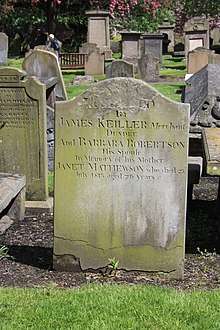Keiller's marmalade
| Type | Marmalade |
|---|---|
| Place of origin | Scotland |
| Region or state | Dundee |
| Created by | Janet Keiller |
| Main ingredients | Oranges |

Keiller's marmalade, is named after its creator James and Janet Keiller (nee Mathewson, 1737-1813), and is believed to have been the first commercial brand of marmalade in Great Britain. It was made by James Keiller in Dundee, Scotland, later creating James Keiller & Son, a brand name which became iconic in the 18th and 19th centuries, and has been sold several times.
In the 18th century, James Keiller on speculation bought a Spanish ship's cargo that included Seville oranges which the ship sought refuge from a raging storm. The ship had started its journey in Seville but the delay caused by the storm had made the oranges less fresh than they ought to have been. The bargain gave Keiller's wife, Janet, the opportunity to manufacture a large quantity of marmalade. She boiled the bitter oranges with sugar which resulted in the creation of orange marmalade.
The true story is that Janet Keiller did not invent marmalade. She modified it. In the 1760s Keiller ran a small confectionery shop producing jams in Seagate, Dundee. She modified a quince-based recipe, marmalato, by shifting to seville oranges, with their bitter rinds, to create shredded peel or "chip" marmalade. The peel was thought to aid digestion, although the pith and much of the fiber was discarded.[1]
James and Janet Keiller were not a couple, but rather son and mother. James Keiller was single at the time that this story takes place. The shipload was probably no more than some boxes, particularly of Seville oranges, which were used medicinally and in a few recipes but not really a fruit consumed fresh.[2] The name "marmalade" originates from the Portuguese word "marmelo" or quince, the fruit which made up the preserve with thin bits of peel. The Keiller contribution was to add the bits of the peel to the marmalade which are the signature of Seville orange marmalades to this day.[3]
The Keillers adapted an existing recipe for mass manufacture, which had been made with quince by adding the characteristic rind suspended in the preserve.
The first commercial brand of marmalade, along with the world's first marmalade plant, was founded in 1797. In 1828, the company became James Keiller and Son, when James junior joined the business[4] In 1859 the company set up a factory in Guernsey in order to avoid the sugar tax charged on the mainland and with a view to eventually expanding business in the south of England. In 1880 the company opened a factory at Tay Wharf, Silvertown in London.[5] By the late 19th century the marmalade was shipping as far afield as Australia, New Zealand, South Africa, India and China.
It is believed that James Keiller and Son was also the first to produce Dundee cake commercially and to give it the distinctive name. By the 1920s, after the firm had been acquired by Crosse & Blackwell, the company had become a producer of a wide range of confectionery, preserves and cakes. After this acquisition in 1920,[5] Keiller was sold again several times before becoming part of another company of Scottish origin, Robertson's. It is now produced by Hain Celestial Group for export only.
One of Janet Keiller's great-great-great grandsons was Alexander Keiller, the noted archaeologist, and one of her great-great-great-great grandsons is the British television presenter Monty Don.[6][7]
James and Janet Keiller are buried in the Howff Cemetery in central Dundee. The grave lies very close to the south-west corner.
References
- ↑ STICKY SITUATION: JAMES KEILLER & SON by THOMAS FARRELL, Let's Look Again (Blog), MARCH 6, 2015
- ↑ Dundee: Keiller’s of Dundee: The Rise of the Marmalade Dynasty, 1800 – 1879, by Dr William Mathew, Abertay Historical Society, ISBN 0 900019 34 4
- ↑ Invented by...Janet Keiller, Scotland Magazine
- ↑ http://www.gracesguide.co.uk/James_Keiller_and_Son
- 1 2 "West Ham: Industries". A History of the County of Essex: Volume 6 (1973). pp. 76–89. Retrieved 2011-03-26.
- ↑ Lynda J Murray1999, "A Zest for Life: the story of Alexander Keiller"
- ↑ http://www.bbcwhodoyouthinkyouaremagazine.com/episode/monty-don